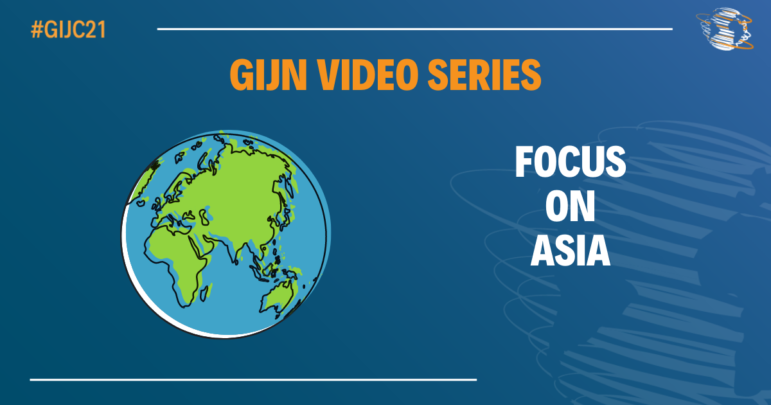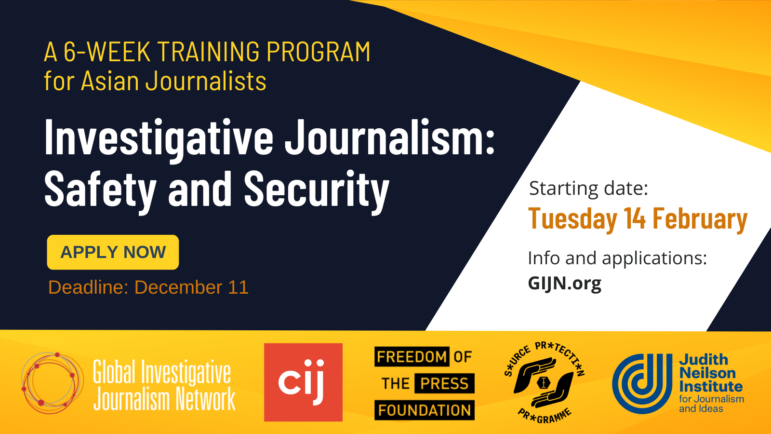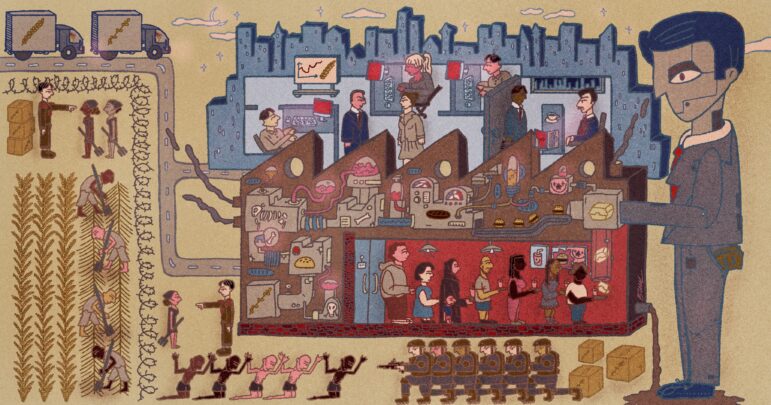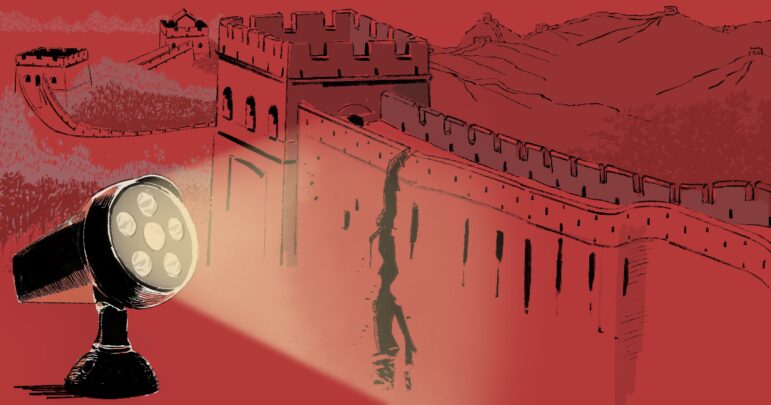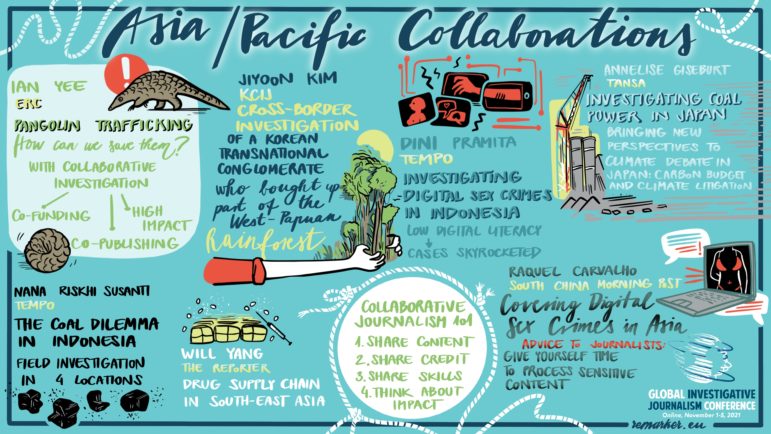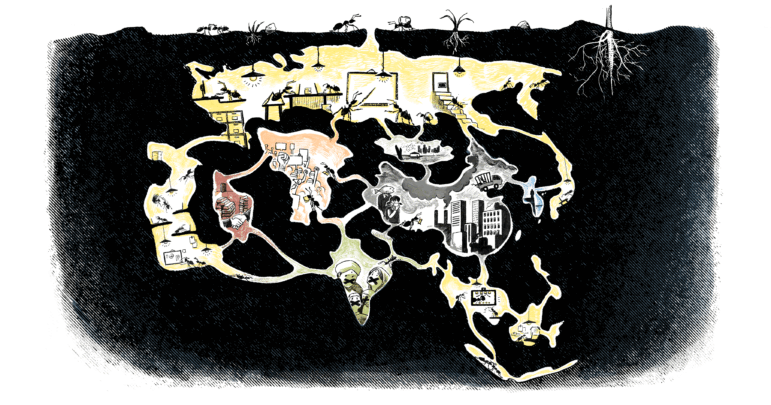

Illustration: Nyuk for GIJN
Investigative Journalism in Asia: Resistance, Transformation, and Solidarity Amidst Mounting Press Challenges
Journalism in Asia has historically been more than just a means of conveying information; it has also been the intellectual grounds for the struggle against colonialism, authoritarianism, and social inequality. In the 19th and 20th centuries, from Bengal to Tokyo, Manila to Istanbul, numerous intellectuals used newspapers as a platform of resistance and for spreading the ideals of journalism, modernization, public consciousness, and freedom.
While journalism in Asia is currently besieged by authoritarian state structures, censorship, and digital misinformation threats, it is also being redefined by younger generations armed with new media tools, and remains an invaluable method for holding power to account. In addition, the continent’s newsrooms are also embracing data and information analysis that approaches storytelling from a more visual, systematic perspective — and brings in new audiences for greater impact.
With its population and ideological diversity, Asia serves as a unique laboratory in the global media landscape. On this vast continent, journalism, especially investigative journalism, goes beyond its role of informing the public; it is often a vital tool for holding authoritarian regimes accountable, exposing corruption, and documenting injustice. However, in fulfilling this role, journalists face multifaceted challenges, such as physical threats, digital surveillance, and financial pressures. According to Reporters Without Borders’ 2025 World Press Freedom Index, a large majority of Asian countries were assessed as having “very serious” press freedom challenges — and seven of the bottom 10 performers worldwide are now in Asia: Russia, Vietnam, Turkmenistan, Afghanistan, Iran, Syria, China, and North Korea. Only three countries, Taiwan, Armenia, and Timor-Leste, were rated by RSF as “satisfactory.”
In many of the countries with dire press conditions, the media are forced to operate under full state control or are completely suppressed. In addition, the press freedom climate in Asia is trending in the wrong direction, due to widespread authoritarian tendencies, internet censorship, and increased pressure on journalists.
But the picture is not universally bleak, and some countries with a stronger legacy of independent journalism are bright spots. Yasuomi Sawa, executive director of Japan’s Journalism Practitioners’ Forum (J-Forum), says investigative reporting in the country is “gaining traction” and increasingly being recognized in national awards for its power to uncover hidden truths. But, he points out, there are still country-specific challenges, from the “secretive mindsets of government officials, lack of concept of “public” in Japanese (like public information, public debate, or going public), the pervasive orientation toward anonymity in society, and the constraints placed upon media attempting to release information under real names.”
As a result, investigative journalism in Asia is not merely surviving but also carving out a niche through new tools, collaborations, and resilience strategies. In places like the Philippines, Indonesia, and Thailand, independent media platforms continue to enjoy public support. Institutions like Rappler (Philippines) and Tempo (Indonesia) influence the region’s public opinion with comprehensive investigations into corruption, environmental destruction, and human rights violations. And the ouster of notoriously repressive regimes in Syria and Bangladesh has provided initial rays of hope for a new era of more open, independent journalism in their aftermath.
To identify some of the most critical challenges facing investigative journalism in the region for this Asia Focus project, GIJN surveyed its 40-plus members across the continent. Many of the responses echoed similar themes: authoritarian pressure, legal restrictions, state and corporate censorship, threats of intimidation and violence, and economic hardship. Editors and reporters across the region told us their investigations span the spectrum from exposing rampant corruption and money laundering, to investigating human trafficking and environmental exploitation — critically important topics that their audiences need them to dig into now more than ever.
“Through Asia Focus we are honoring the incredible work being done by members from the community across the region, despite the complex press freedom environment,” says Emilia Díaz-Struck, GIJN’s executive director. “We are launching this special Asia Focus publication a few weeks before co-hosting with Malaysiakini our Global Investigative Journalism Conference for the first time in our organization’s history in Asia. We expect this to be a space for solidarity and knowledge sharing that will contribute to continuing to empower the investigative journalism community in the region and around the world.”
Central Asia and the Caucasus
There has been a renewed crackdown on press freedom in the Caucasus. Despite mass protests in Georgia, lawmakers recently voted for a controversial “foreign agents” law, based on the Russian model, which civil society and media organizations fear could be used to muzzle dissent and the press. And in Azerbaijan, more than a dozen journalists have been arrested on charges of currency smuggling for receiving allegedly illegal funds — money that was grant funding for journalism from respected international donors.
“Investigative journalism here also means resilience,” says Fatima Karimova, co-founder and editor-in-chief at GIJN member-in-exile Mikroskop Media. “Working with limited access to data and resources, journalists rely on creativity, alternative sources, and cross-border collaborations to uncover corruption, human rights abuses, and misuse of power — often at significant personal and professional risk.”
Challenges for journalism are also sweeping across Central Asia. After an investigation into potential corruption in the Kyrgyz president’s administration was published, reporters from Temirov Live were arrested, with some of the team jailed and charged with “creating a criminal group” and “inciting mass unrest.” A Kyrgyz court also ordered the closure of the investigative media outlet and GIJN member Kloop, and recently two of the site’s camera crew were sentenced to five years in jail on “bogus charges,” according to CPJ and Amnesty International.
“Media outlets are being shut down or financially strangled, while new laws are weaponized to silence critical voices,” warns Kloop editor-in-chief Anna Kapushenko. “Despite these pressures, investigative journalism in Kyrgyzstan continues to stand out for its courage, resilience, and commitment to accountability.”
Ruslan Myatiev, editor of the exiled GIJN member Turkmen.news also highlighted restricted access to data as an additional obstacle to watchdog reporting in the region. “Investigative reporting in Central Asia is currently at its birth stage,” Myatiev says. “The government doesn’t publicize any registers, so digging out corruption and wrongdoing is extremely difficult. However, people are also sick of corruption, including those who take high positions. They are our primary source of data and information, which then become decent investigative pieces.”
Turkey
Investigative journalism in Turkey is under severe legal, political, and economic pressure, yet remains active through the efforts of independent journalists, NGOs, and foundations. One of the most consequential recent developments is the passage of a 2022 disinformation law, which criminalizes “false or misleading information” that may harm public order, security, or public health. The law has been used to launch thousands of investigations since its passage and to prosecute dozens of journalists. Journalists like Ahmet Kanbal (Mezopotamya), İsmail Arı (BirGün), and others have faced cases under this law for reporting on elections, earthquake aftermaths, or state‐run institutions.
Press freedom indices reflect this erosion: Turkey ranks very low in the 2025 World Press Freedom Index (159th out of 180 countries). Regulatory bodies have been leveraged to impose fines, withdraw state advertising, block access to content, or suspend broadcast licenses of critical or opposition‐aligned outlets. Physical risks, arrests, harassment both online and offline, and judicial threats are common. Journalists covering protests, corruption, and disasters like the February 2023 earthquake face obstruction, detention, and other forms of suppression. A recent survey by the Turkish Journalists’ Union found that 43% of journalists surveyed had experienced censorship, with younger and women journalists more often affected. Likewise, 25% say they frequently self‐censor.
Because of these trends, independent and nonprofit institutions have become critical for accountability reporting. For example, the Uğur Mumcu Investigative Journalism Foundation trains and sustains skills and ethics among young reporters, even when mainstream media is constrained. In addition, journalists who have won international awards demonstrate the importance of this field in Turkey and its impact at the international level. Social media and digital platforms enable investigative journalism to reach wider audiences, but the biggest obstacle in this field remains serious threats to freedom of expression and independence.
India and Sri Lanka
During the last decade, the media landscape in this region has undergone a significant change, with government control now more pronounced than ever before. The majority of mainstream media outlets inside India, in particular, have largely become the vehicles for the ruling party’s propaganda. Many prominent TV news channels are owned by businesses that shape content to favor the government’s interests. In this environment, genuine investigative journalism has been pushed to the margins, surviving mostly outside the mainstream news cycle.
At the same time, press freedom in this region has been steadily declining, with journalists facing legal harassment through defamation, sedition, and anti-terror laws. Physical threats and online abuse are common, and economic constraints are acute. India’s ranking on the World Press Freedom Index has fallen in recent years to 151st in 2025, while Sri Lanka’s now stands at 139th. As a result, investigative reporting is increasingly sustained by donor-funded and subscription-based outlets, as mainstream media avoids such reporting due to government and advertiser pressures.
“Asian investigative newsrooms often face immense financial strain, government crackdowns, legal threats, corporate control, and disinformation attacks from online trolls,” explains Mayank Aggarwal, editor at The Reporters’ Collective. “Despite such challenges, the investigative newsrooms in the region, including many grassroots organizations, are a shining example of what determined independent newsrooms can achieve by finding allies. To overcome their constraints, they use digital tools, freedom of information laws, collaborate with experts, and social media to uncover corruption, seek accountability, and report on all wrongdoings that governments and corporations hide.”
Digital media platforms in India have created alternative spaces for stories that genuinely matter to the public. GIJN member The Reporters’ Collective has gained renown for its investigations, uncovering issues such as the opacity in electoral bonds, irregularities in government schemes, and the nexus between corporations and politicians. The Scroll and The Wire have probed issues of surveillance, environmental violations, and misuse of state power, while The Caravan magazine has offered in-depth narratives on communal violence, the judiciary, and political corruption. Newslaundry, meanwhile, has focused on the media itself, investigating ownership patterns, disinformation, and the erosion of editorial independence.
“Some of the most powerful and impactful investigative reporting continues to happen in Asia. It also provides greater opportunity for collaborative journalism,” says Dilrukshi Handunnetti, co-founder of Sri Lanka’s Center for Investigative Reporting, one of two GIJN members in the country. She cites this recent CIR investigation linking climate change to a growing vulnerability to dengue as an example of the power of innovative journalism, combining academic research with accountability journalism. She points out that this story was the first time a direct scientific connection had been made between these issues inside Sri Lanka. “The story has been hailed by the health authorities and the public,” Handunnetti notes.
Pakistan
Press freedom in Pakistan has always been subject to challenges. And while there have been marginal improvements in its rating in recent years on the World Press Freedom index, the country still ranks 158th, amongst the worst in the world, colored blazing red on RSF’s world press freedom map.
Growing censorship by the state of all forms of media — be it digital, print, or electronic — is a major contributor. In addition, consolidation of the media by large businesses and revenue models vulnerable to state capture, where these same outlets depend upon government advertisements, combine to make for a difficult environment for accountability journalism to survive.
Despite these restrictions, independent digital media outlets do exist. The data-driven investigative site Fact Focus has published in-depth investigations exposing government corruption at the highest offices. Other sites like GIJN member Lok Sujag are going hyper-local to report on the smaller cities and towns in the country. Journalists have also chosen to go independent using social media, primarily YouTube, to earn money and host their own, more personal media channels free from corporate constraints.
The state has tried to counter this latter trend by amending laws on digital content and defamation in online spaces as well as engaging in straight-up harassment. For instance, the co-founder of Fact Focus doesn’t live in Pakistan, nonetheless, his family still inside the country has faced legal threats, which many activists and journalists see as a clear attempt at intimidating or silencing him. Going one step further — and emblematic of the dire straits facing the press in Pakistan right now — the government has even blocked the Fact Focus website.
Middle East
Investigative journalists in the Arab world face serious, existential challenges every day: targeted attacks, deadly conflicts, draconian laws, and limited funding. While there are some bright spots, like the intrepid coverage of reporters inside Gaza and the re-emergence of some press freedoms after the ouster of the Assad regime in Syria, major obstacles loom.
Nowhere are the threats to the press more apparent than in Palestine. Israel’s ongoing bombing campaign and ground assault in Gaza since Hamas’ incursion two years ago is estimated to have led to more than 65,000 civilian casualties so far. Meanwhile, it has prohibited any outside journalists from covering the widespread deaths, which a recent UN commission report now classifies as “genocide.” In addition, the Committee to Protect Journalists and the International Federation of Journalists have documented the killing of more than 200 media workers in Gaza since the outbreak of the war, some of whom CPJ claims were intentionally targeted by the Israeli military.
In other Middle Eastern countries, like Jordan, Qatar, and Lebanon, a series of strict press laws have hindered investigative work. Between 2023 and 2025, independent outlets in Lebanon, such as Daraj, have faced scrutiny from the state prosecutor for their work.
Adding to an already chilled press atmosphere in the region was an abrupt and devastating freeze on USAID financial support this year, which severely impacted the region’s development sector, leading to many journalism program suspensions or cuts. Rawan Damen, managing director at GIJN member ARIJ, describes the impact on that organization: “The funding freeze means a loss of roughly 20% of our annual budget that was supposed to support several projects, including an environmental journalism fellowship and our annual forum.”
Despite these challenges, journalists in the region work hard to hold wrongdoers accountable. ARIJ and others investigated the killings of Gaza journalists in The Gaza Project. In Syria, a recent collaboration between international and Syrian news outlets showed how the former regime kidnapped and trafficked children. In addition, this year Reuters published a major series about the new, post-Assad regime, including details on massacres and corruption. And a recent, cross-border BBC investigation revealed the trafficking and exploitation of Ugandan women in the Persian Gulf.
China, Hong Kong, and Taiwan
With its press freedom consistently ranked among the lowest in the world, China has imprisoned more journalists than any other country every year since 2014. Today, both China’s established news industry and its unique tradition of investigative journalism are on the verge of extinction, replaced by the Chinese Communist Party’s (CCP) complete control over the media landscape. And China’s “Great Firewall” continues to grow stronger, fostering a closed digital ecosystem where all social media content — from publication and dissemination to user feedback — is strictly censored across platforms like WeChat, Zhihu, and Xiaohongshu.
As institutional media has been neutered and private outlets systematically shut down, what little remains of critical Chinese journalism now exists in small, decentralized groups. These operations are typically de-institutionalized, highly specialized in the topics they cover, and scattered unevenly across the social media landscape. Many of these news site leaders are professional journalists trained during the more open era of 2003–2013. They now tackle subjects that are taboo for state media, often under the guise of literary nonfiction or personal stories that explore individual fates and choices.
As press freedom in China has deteriorated, a growing number of the country’s journalists have chosen or been forced to go into exile. Among the most prominent are former CCTV reporters Chai Jing and Wang Zhi’an. Both have built massive followings of over one million subscribers on YouTube, granting them significant influence outside of state control. In addition to these high-profile figures, recent years have also seen the rise of anonymous, independent media platforms like Mang Mang Magazine and WOMEN, founded by journalists seeking to continue their work from abroad.
Press freedom in Hong Kong has deteriorated rapidly since the passage of the National Security Law in 2020. The two largest pro-democracy outlets were shuttered years ago, and Radio Television Hong Kong (RTHK) has been transformed from a public broadcaster into an official state mouthpiece. Independent Chinese-language media outlets are now an endangered species, but despite this, recent years have seen the emergence of new investigative outlets, such as The Collective. Furthermore, as large numbers of Hongkongers have moved abroad, a wave of exile-run media organizations has appeared, including The Chaser News, Flow HK Magazine, Green Bean Media, and Photon Media.
Taiwan, by contrast, has far greater press freedom than mainland China or Hong Kong and enjoys the highest overall rating for the continent, ranked 24th worldwide by RSF. Nevertheless, it still faces the spread of disinformation and impact of news avoidance, says Sherry Lee, COO and former editor-in-chief of GIJN member The Reporter. “The challenge is different yet equally profound,” Lee says. “The infiltration of disinformation and the pervasive influence of China. These forces have led many people to avoid news, and to approach information and journalism with deep skepticism — sometimes even with a sense of nihilism.”
Bangladesh
Investigative journalism remains under pressure in Bangladesh, although the recent overthrow of the repressive Awami League government has sparked some cautious optimism, and the country’s World Press Freedom Index ranking has jumped 16 points in the past year. Still, the media is wary of the new regime and continues to move slowly in publishing major investigative news amid the uproar and uncertain political situation.
This caution is, in part, due to the continuation of the country’s Anti-Terrorist Act, passed back in 2009. This law has routinely been weaponized to attack and intimidate the press and has created a precedent of prosecuting and imprisoning journalists for publishing stories that embarrass those in power or expressing dissent. A Daily Star data investigation found that 266 journalists in the country face criminal charges related to the 2024 nationwide protests that led to the government’s ouster and more than 20 journalists are now in jail. Prominent journalist Manjarul Alam Panna was arrested while giving a talk at a seminar, based on charges related to the Anti-Terrorist Act.
While journalists in Bangladesh continue to work under these challenging circumstances, there is concern about a decline in the number of major investigative reports. Many media outlets are deliberately following a “wait and see” policy, as a way to navigate the country’s current political transition period. This approach has left some journalists frustrated, as it restricts their ability to pursue and publish hard-hitting stories despite having access to important information.
Southeast Asia
Investigative journalism across Southeast Asia varies wildly. In countries like Myanmar, Vietnam, Laos, and Cambodia, an independent press does not functionally exist, as the countries have outright or de facto state control of the media. Other nations, like Thailand (85th) and Malaysia (88th) have seen modest gains in RSF’s World Press Freedom rankings and enjoy examples of strong accountability reporting sites, among them GIJN member Malaysiakini, which will co-host the Global Investigative Journalism Conference this year, and the Bangkok-based Prachatai. While some, like Singapore and Indonesia, have experienced notable declines in their press climates in the past decade.
In the region’s most populous nation, Indonesia, various forms of violence — ranging from verbal abuse and intimidation, physical violence, criminalization, to murder — continue to befall journalists, with most perpetrated by the police, according to the country’s Independent Journalists Alliance (IJA). Cyberattacks such as doxxing, account hijacking, and DDoS attacks also continue to target journalists and the mass media.
The dire situation has been exacerbated by a collapse in sustainable funding for independent media due to an executive order issued by US President Donald Trump. “Following Trump’s executive order that led to the closure of USAID, a number of independent media outlets in Indonesia lost their support for conducting quality investigative reporting,” explains Fransisca Susanti, executive director of GIJN member JARING, which offers capacity building, content production, and emergency assistance for media in the country.
“Media outlets generally lack a dedicated budget. Most investigative reporting in Indonesia comes from outside sources, including international funding,” explains Bayu Wardhana, IJA secretary general. As a result, he warns there is a deficit in covering the country’s policies about natural resources, which are often “environmentally destructive and controlled by a handful of people.”
Despite these challenges, Bayu believes that investigative journalism is still thriving thanks to the persistence of projects like IndonesiaLeaks and the Investigative Journalists Club (KJI). Hope also continues to grow, Sustani says, thanks to “collaboration not only between media outlets, but also between the media and NGOs to make investigative reporting more impactful.”
GIJN’s regional editors for the Asian region collaborated in writing this report. They include Pinar Dağ, Olga Simanovych, Deepak Tiwari, Amel Ghani, Majdoleen Hasan, Joey Qi, SK Tanvir Mahmud, and Kholikul Alim.
Nyuk was born in 2000 in South Korea. He is currently studying at the Department of Applied Art Education at Hanyang University in Seoul, South Korea, where he also works as an illustrator. Since the exhibition at Hidden Place in 2021, he has participated in various illustration exhibitions. He is mainly interested in hand drawing, which represents the value of his art world.

